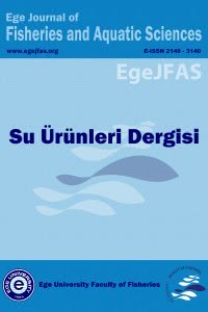Mikroalg üretimi için fotobiyoreaktör tasarımları
algler, üretim, kapalı sistemler, biyoteknoloji, sucul kültür
The designs of photobioreactors for microalgae production
algae, production, closed systems, biotechnology, aquaculture,
___
Acien Fernandez, F. G., Garcia Camacho, F., Sanchez Perez, J. A., Fernandez Sevilla, J. M., & Molina Grima, 1998. Modelling of biomass productivity in tubular photobioreactors for microalgal cultures: Effects of dilution rate, tube diameter and solar irradiance. Biotechnology and Bioengineering, 58; 605-616.Baynes, S. M., Emerson, L, Scott, A. P., (1979). Production of algae for use in the rearing of larval fish. Fisheries Re search Technical Report 53; 13- 18.
Beijerink, M. W., 1890. Kulturversuche mit Zoochloren, Lichenengonidien und anderen niederen Algen. Bot. Ztg. 48; 725-785.
Belay, A., 1997. Mass culture of Spirulina outdoors. The Earthrise Farms experience. In: Vonshak, A. (eds.), Spirulina platensis (Arthrospira): Physiology, cell-biology and biotechnology. Taylor and Francis, London; 131-158.
Borowitzka M.A., 1992. Algal biotechnology products and processes: matching science and economics. J Appl Phycol 4; 267-279
Burlew, J. S. (eds.), 1953. Algae Culture. From Laboratory to Pilot Plant. ' Carnegie Institution of Washington, Washington, DCBorowitzka MA, Borowitzka LJ (eds) (1988) Micro-algal biotechnology. Cambridge University Pres, Cambridge
Chrismadha, T., Borowitzka, M. A., 1994. Effectof cell density and irradiance on growth, proximate composition and eicosapentaenoic acid production of Phaeodactylum tricornutum grown in a tubular photobioreactor. J. Appl. Phycol. 6; 67-74.
Cohen, E., Arad, S., 1989. A closed system for outdoor cultivation of Porphyridium. Biomass 18; 59-67.
Durand Chastel, H., 1980. Production and use of Spirulina in Mexico. In: Shelef, G., Soeder, C. J. (Eds.), Algae Biomass. Elsevier/North Holland Biomedical Pres, Amsterdam;51-64.
Fulks, W., Main, K.-L, 1991. The design and operation of commercial-scale live feeds production systems. In: Fulks, W., Main, K. L. (eds.), Rotifer and Microalgae Culture Systems. The Oceanic Institute, Honolulu, H. I.; 3-52.
Gudin, C, Chaumont, D. 1983. Solar biotechnology study and development of tubular solar receptors for controlled production of photosynthetic cellular biomass. In W. Palz, & D. Pirrwitz (eds.), Proceedings of the Workshop and E. C. Contractor's meeting in Capri (pp. 184-193). Dordrecht: D. Reidel Publishing Company.
Kargın, H., 2002. Mikroalg- Rotifer Kültür Sistemleri ve Tasarımları, Yardımcı ders kitabı, ME. Ü. Yayınları No. 5, Su Ürünleri Fakültesi Yayınları No. 3; ISBN 975-6900-08-3; 15-16.
Kargın, H., 2004. Tübüler Sistemde Tetraselmis suecica Alg Türünün Büyüme Hızı ve Ürün Verimliliği. ME.Ü. BAP SÜF TBB (HK) 2001-3 no'lu proje.
Kawaguchi, K., 1980. Microalgae production systems in Asia. In: Shelef, G., Soeder, C. J. (Eds.), Algae Biomass Production and Use. Elsevier/North Holland Biomedical Pres, Amsterdam; 25-33.
Kennedy, C. A., 1998. In Home Photosynthetic Bioreactor. Advanced Biology Home Page Webmaster.
Lee, Y. K., 1997. Commercial production of microalgae in the Asia-Pacific rim. J. Appl. Phycol. 9; 403-411.
Molina Grima, E. 1999. Microalgae, mass culture methods. In M. C. Flickinger, & S. W. Drew (eds.), Encyclopedia of bioprocess technology: Fermentation, biocatalysis and bioseparation, New York: Wiley,.vol. 3; 1753-1769.
Park, K.-H. and C.-G. Lee, 2000. Optimization of algal photobioreactors using flashing lights. Biotechnol. Bioproc- ess Eng. 5; 186-190.
Pulz, O., 1994. Open-air and semi-closed cultivation systems for the mass cultivation of microalgae. In; Phang, S. M., Lee, K., Borowitzka, M. A., Whitton, B. (eds.), Algal Biotechnology in the Asia- Pasific Region. Institute of Advenced Studies, University of Malaya, Kuala Lumpur; 113- 117.
Pulz, O., 2001. Photobioreactors: production systems for phototrophic microorganisms. IGV Institute for Cereal Processing, Arthur- Scheunert- Allee 40/41,14558 Bergholz-Rehbrücke, Germany.
Robinson and Marrison, 1992. Alga Clorella Vulgaris coltivazione, estrazione e purificazione di una glicoproteina ad azione antitumorale , Anno Accademico 2001 - 02, pp 7-15.
Soong, P., 1980. Productrion and development of Chlorella and Spirulina in Taiwan. In: Shelef, G., Soeder, C. J. (Eds.), Algae Biomass. Elsevier/North Holland Biomedical Pres, Amsterdam; 97-113.
Tredici, M. R., Zitelli, G. C, 1997. Cultivation of Spirulina (Arthrospira) platensis in flat plate reactors. In: Vonshak, A. (ed.), Spirulina platensis (Arthrospira): Physiology, cell-biology and biotechnology. Taylor and Francis, London; 117-130.
Tredici, M.r., 1999. Bioreactors, photo. In: Flickinger M. C, Drew S.w., (Eds) Encyclopedia of bioprocess technology: fermentation, biocatalysis and bioseparation, vol 1. Wiley, New York; 395419.
Tsukada, O., Kawahara, T., Miyachi, S.,1977. Mass culture of Chlorella in Asian countries. In: Mitsui, A., Miyachi, S., San Pietro, A., Tamura, S. (Eds.), Biological Solar Energy Conversion. Academic Pres, New York; 363-365.
Tsoglin and Gabel 2000. The technology of production of biomass labeled with stable isotopes. Abstracts of the 4th European workshop on biotechnology of microalgae. Bergholz-Rehbrücke, Germany.
Torzillo, G., Pushparaj, B., Boci, F., Balloni, W., Materassi, R., & Florenzano, G. 1986. Production of Spirulina biomass in closed photobioreactors. Biomass, 11; 61-64.
Tomaselli, L, Giovannetti, L, Torzillo, G., 1993. Physiology of stres response in Spirulina, Spirulina, Algae of Life. In: Doumenge, F.; Durand- Chastel, H. & Toulemont, A. (eds). Spiruline Algue de Vie. Bulletin de L'lnstitut Oceanographique, Monaco, n.12, p. 65-75,1993.
Venkatamaran, L. V., 1986. Blue-green algae as biofertilizer. In: Richmond, A. (Ed.), CRC Handbook of Microalgal Mass Culture. CRC Pres, Boca Raton, FL; 455-471.
Warburg, O., 1919. Über die Geschwindigkeit der Kohlensâurezusammensetzung in lebenden Zellen. Biochemische Zeitschrift 100; 230-270.
Watson, A. S., 1979. Aquaculture and Algae Culture. Process and Production. Noyes Data Corporation, N. J.
http://www. biosynthesis, couk/products.htm, 2.Agus.2004
http://www.addavita.demon.co.uk/howthe.htm,24.05.2005
- ISSN: 1300-1590
- Yayın Aralığı: 4
- Başlangıç: 1984
- Yayıncı: Aynur Lök
Eğirdir Gölü (Isparta)' nün doğal yapısına yapılan müdahalelerin gölün ekolojik yapısına etkileri
Karataş kıyısal suları (Kuzey Doğu Akdeniz) planktonik diyatomları
Çipura (Sparus aurata) balıklarının farklı yemlere olan atak modelleri ve yetiştiricilikte kullanımı
B. Ahmet BALCI, Ramazan İKİZ, Beria Falakalı MUTAF
HAKAN MURAT BÜYÜKÇAPAR, AHMET ALP, Mustafa KAYA, Yusuf ÇİÇEK
Ahtopot (Octopus vulgaris Cuvier, 1797) yetiştiriciliği
Süleyman BALIK, M. Ruşen USTAOĞLU, MURAT ÖZBEK, SERAY YILDIZ, AYŞE TAŞDEMİR, ALİ İLHAN
Pelajik balık avcılığında teknik ve ekonomik açıdan pratik ve etkin bir av aracının geliştirilmesi
Dilek İşgören EMİROĞLU, AYTAÇ ÖZGÜL, Cezmi KANÇOBAN
Benal GÜL, Altan LÖK, F. Ozan DÜZBASTILAR
Orta Karadeniz Bölgesi Balıkçılığı ve balıkçıların sosyo-ekonomik durumu
